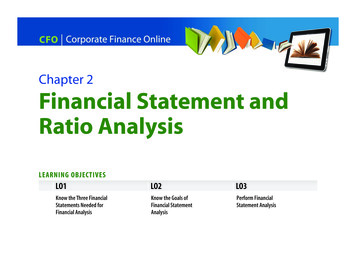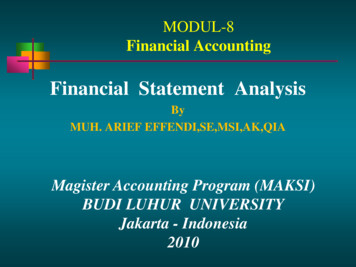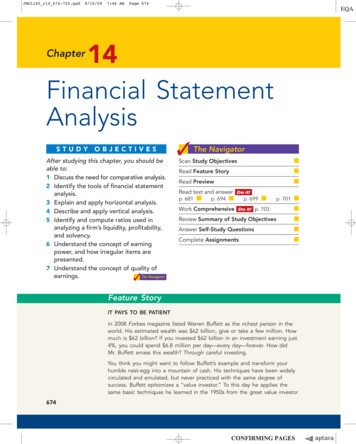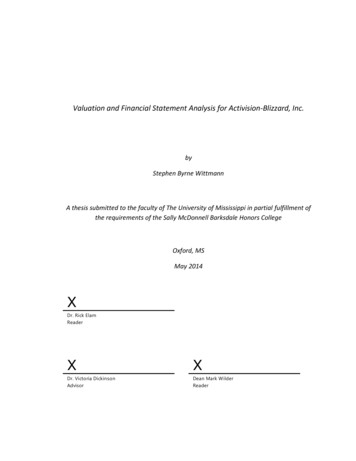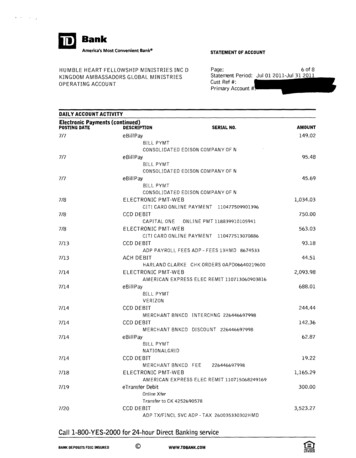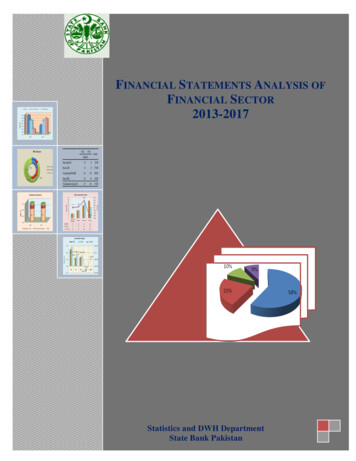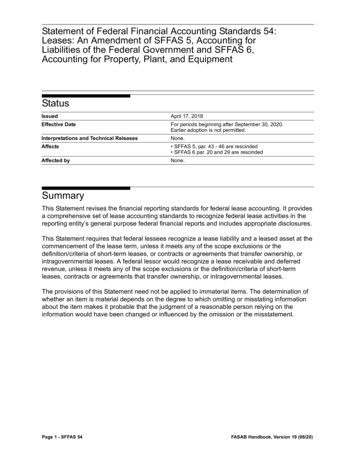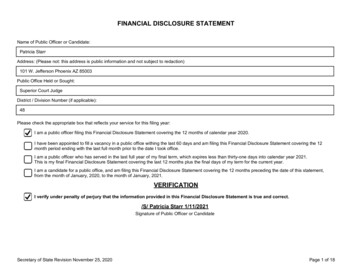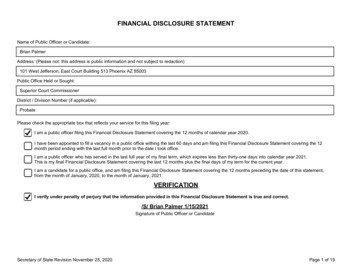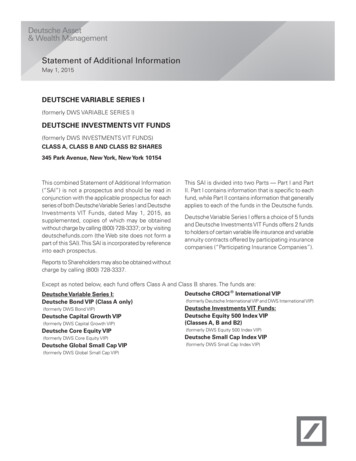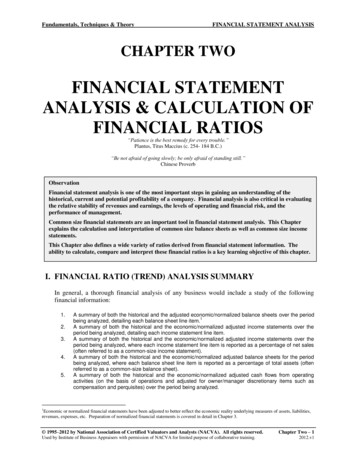
Transcription
Fundamentals, Techniques & TheoryFINANCIAL STATEMENT ANALYSISCHAPTER TWOFINANCIAL STATEMENTANALYSIS & CALCULATION OFFINANCIAL RATIOS“Patience is the best remedy for every trouble.”Plantus, Titus Maccius (c. 254- 184 B.C.)“Be not afraid of going slowly; be only afraid of standing still.”Chinese ProverbObservationFinancial statement analysis is one of the most important steps in gaining an understanding of thehistorical, current and potential profitability of a company. Financial analysis is also critical in evaluatingthe relative stability of revenues and earnings, the levels of operating and financial risk, and theperformance of management.Common size financial statements are an important tool in financial statement analysis. This Chapterexplains the calculation and interpretation of common size balance sheets as well as common size incomestatements.This Chapter also defines a wide variety of ratios derived from financial statement information. Theability to calculate, compare and interpret these financial ratios is a key learning objective of this chapter.I. FINANCIAL RATIO (TREND) ANALYSIS SUMMARYIn general, a thorough financial analysis of any business would include a study of the followingfinancial information:1.2.3.4.5.A summary of both the historical and the adjusted economic/normalized balance sheets over the period1being analyzed, detailing each balance sheet line item.A summary of both the historical and the economic/normalized adjusted income statements over theperiod being analyzed, detailing each income statement line item.A summary of both the historical and the economic/normalized adjusted income statements over theperiod being analyzed, where each income statement line item is reported as a percentage of net sales(often referred to as a common-size income statement).A summary of both the historical and the economic/normalized adjusted balance sheets for the periodbeing analyzed, where each balance sheet line item is reported as a percentage of total assets (oftenreferred to as a common-size balance sheet).A summary of both the historical and the economic/normalized adjusted cash flows from operatingactivities (on the basis of operations and adjusted for owner/manager discretionary items such ascompensation and perquisites) over the period being analyzed.1Economic or normalized financial statements have been adjusted to better reflect the economic reality underlying measures of assets, liabilities,revenues, expenses, etc. Preparation of normalized financial statements is covered in detail in Chapter 3. 1995–2012 by National Association of Certified Valuators and Analysts (NACVA). All rights reserved.Used by Institute of Business Appraisers with permission of NACVA for limited purpose of collaborative training.Chapter Two – 12012.v1
FINANCIAL STATEMENT ANALYSIS6.A summary of the five main categories of selected financial ratios over the period being analyzed are:a.b.c.d.e.7.Fundamentals, Techniques & TheoryInternal liquidity ratiosOperating efficiency ratiosOperating profitability ratiosBusiness risk (operating) analysis ratiosFinancial risk (leverage) analysis ratiosThe valuation analyst should then compare the aforementioned ratios for the subject company to thosefor other specific businesses or to an appropriate industry average.II. COMMON-SIZE ANALYSISThe conversion of balance sheet and income statement line items to percentages of a total is oftenreferred to as placing the statements on a “common-size” basis. For purposes of common- sizestatements, balance sheet line items are presented as a percentage of total assets and incomestatement line items are presented as a percentage of total net sales or gross revenue.Converting the subject company’s balance sheets and income statements to a common-size basisassists the analyst by identifying internal trends. Common-size statements also facilitate comparisonwith other companies in the same industry. A comparison with the data of one or more othercompanies if done on the basis of absolute dollar amounts would be very confusing and timeconsuming without common-size analysis. Further, comparisons with industry averages arefacilitated and made more efficient by using common-size analysis.Because common-size financial statement analysis is based on relative size, it removes the confusionthat prevails when exact dollar amounts are used. It is also a fundamental step in developing ratio(trend) and comparative analyses.III. RATIO (TREND) ANALYSISA. OVERVIEWFinancial ratios are measures of the relative health, or sometimes the relative sickness of abusiness. A physician, when evaluating a person’s health, will measure the heart rate, bloodpressure and temperature; whereas, a financial analyst will take readings on a company’sgrowth, cost control, turnover, profitability and risk. Like the physician, the financial analystwill then compare these readings with generally accepted guidelines. Ratio analysis is aneffective tool to assist the analyst in answering some basic questions, such as:1.2.3.How well is the company doing?What are its strengths and weaknesses?What are the relative business and operating risks to the company?Please note that although an analysis of financial ratios will help identify a company’s strengthsand weaknesses, it has its limitations and will not necessarily identify all strengths andweaknesses, nor will it provide the solutions or cures for the problems it identifies. Forinstance, off balance sheet financing techniques are not included or reflected in the balancesheet. Typical off- balance sheet items include:2 – Chapter Two2012.v1 1995–2012 by National Association of Certified Valuators and Analysts (NACVA). All rights reserved.Used by Institute of Business Appraisers with permission of NACVA for limited purpose of collaborative training.
Fundamentals, Techniques & Theory1.2.3.4.5.6.7.FINANCIAL STATEMENT ANALYSISThe use of operating leases (vis-à-vis- capitalized lease)Use of finance affiliatesSales or factoring of receivablesUse of securitizationTake-or-pay and throughput contractsUse of joint venturesGuaranteeing the debt of affiliatesIn addition, historical financial data has limitations since the subject firm can:1.2.3.4.5.6.7.8.Record questionable revenueRecord revenue too soonRecord sham revenueRecord one-time gains to boost incomeShift expenses either to an earlier or later periodUnder-report or improperly reduce liabilitiesShift revenues to the futureTake current charges to shift future expensesTo make the most effective use of financial ratios, the ratios should be calculated and comparedover a period of several years. This allows the valuation analyst to identify trends in thesemeasurements over time. These ratios can also be compared to specific other companies or toindustry averages or norms in order to see how the subject company is performing relative toother businesses in its industry during the same period of time.Once the analyst has obtained the GAAP basis and/or tax basis balance sheets and incomestatements and has prepared a summary of the historical economic/normalized balance sheetsand income statements, then an analysis of the key financial statement ratios can be undertaken.B.APPLICATION OF RATIO ANALYSIS1.An Analysis of Financial Ratios is a Useful Tool for Business Valuationsa)Integral tool in trend analysis(1) Compares the company’s own ratios to itself over time(2) Identifies the company’s strengths and weaknesses(3) Assists in establishing appropriate capitalization rates (helps to identify riskfactors particular to the subject company) (See Chapter Five)b)Integral tool in comparative analysis(1) Assists in making comparisons with other companies’ or industry averages(2) Assists in selecting appropriate price/earnings ratios or price/asset multiplesrelative to the company’s indicated performance to compare to comparablecompanies or industry averages 1995–2012 by National Association of Certified Valuators and Analysts (NACVA). All rights reserved.Used by Institute of Business Appraisers with permission of NACVA for limited purpose of collaborative training.Chapter Two – 32012.v1
FINANCIAL STATEMENT ANALYSIS2.Fundamentals, Techniques & TheoryUses Historical Dataa)b)c)3.Preferably for five years or alternatively, the length of the natural business cycle of thesubject company and industryMore than five years when the analyst deems appropriateLess than five years when the analyst uncovers unavailability of information, unusualfluctuations or a specific valuation purposeSteps in Trend Analysisa)b)c)d)4.Obtain and analyze GAAP basis or tax basis financial dataList and prepare summaries by year for key financial statement accounts (both balancesheet and income statement items)Select, compute and compare the relevant financial ratios for each yearAnalyze and develop conclusions. This analysis will highlight questionable orunusual items to be discussed with management for clarification or potentialadjustmentObservationThe most effective way to compare and analyze several years of financial data is to preparea spreadsheet, either standalone or by using a valuation software program that lists thedescription of the financial data and the respective years. The majority of softwareprograms list the descriptions vertically and the years (or other timing) horizontally,allowing easy side-by-side comparisons of financial information.IV. KEY FINANCIAL RATIOSThe thorough valuation analyst will consider and compute five categories of ratios:1.2.3.4.5.Internal liquidity ratiosOperating efficiency ratiosOperating profitability ratiosBusiness risk (operating) analysis ratiosFinancial risk (leverage) analysis ratiosThe following section provides a summary of the five categories of financial ratios, along withdescriptions of how each ratio is calculated and its relevance to financial analysis. Remember, theratios themselves may not be entirely meaningful unless used in trend analysis or comparativeanalysis.A. INTERNAL LIQUIDITY RATIOSThe internal liquidity ratios (also referred to as solvency ratios) measure a firm’s ability to payits near-term financial obligations.1.Current RatioCurrent Ratio4 – Chapter Two2012.v1 Current AssetsCurrent Liabilities 1995–2012 by National Association of Certified Valuators and Analysts (NACVA). All rights reserved.Used by Institute of Business Appraisers with permission of NACVA for limited purpose of collaborative training.
Fundamentals, Techniques & TheoryFINANCIAL STATEMENT ANALYSISThis ratio provides a good measure of solvency if accounts receivable and inventories areliquid.2.Quick RatioQuick Ratio Cash Marketable Securities ReceivablesCurrent LiabilitiesIf inventories are not easily liquidated, the quick ratio provides a better indicator of thefirm’s financial solvency vis-à-vis the current ratio.3.Cash RatioCash Ratio Cash Marketable SecuritiesCurrent LiabilitiesThe cash ratio is the most conservative measure of solvency; it is used if neither accountsreceivables nor inventories are liquid4.Receivable TurnoverReceivable Turnover Net Sales((Beginning A/R Ending A/R) 2)This calculation finds the ratio between the net sales for the period and the average balancein accounts receivable. The resulting ratio is a measure of how many times accountsreceivable are collected (or turned over) during the period being examined. For example, aratio of 6 indicates that accounts receivable, on average, were completely collected 6 timesover the past year, or every two months.The analyst can further convert the turnover ratio by dividing it into 365. This yields arough indication of the average time required to convert receivables into cash. Ideally, amonthly average of receivables should be used and only sales on credit should be includedin the sales figure. The interpretation of the average age of receivables depends upon acompany’s credit terms and the seasonable activity immediately before year–end. If acompany grants 30 days credit terms to its customers, for example, and a turnover analysisindicates average collection time of 41 days, then accounts receivable collections arelagging. If the terms were for 60 days, however, it appears collections are being madeahead of schedule. Note, if the sales volume in the last month of the year is unusuallylarge, the average age of receivables as computed above can be misleading.5.Inventory TurnoverInventory Turnover Cost of Goods Sold((Beginning Inventory Ending Inventory) 2)This ratio measures the number of times a company sells (or turns) its inventory during theyear. The relationship between inventory turnover and the gross profit rate may beimportant. A high inventory turnover and a low gross profit rate frequently go hand in 1995–2012 by National Association of Certified Valuators and Analysts (NACVA). All rights reserved.Used by Institute of Business Appraisers with permission of NACVA for limited purpose of collaborative training.Chapter Two – 52012.v1
FINANCIAL STATEMENT ANALYSISFundamentals, Techniques & Theoryhand. This, however, is merely another way of saying if the gross profit rate is low ahigher volume of business is necessary to produce a satisfactory return on total assets.Although, a high inventory turnover is usually regarded as a good sign, a rate that is high inrelation to that of similar firms may indicate the company is losing sales by failing tomaintain an adequate stock of goods to serve its customers promptly.High inventory turnover can also indicate better liquidity or superior merchandising.Conversely, it can indicate a shortage of needed inventory for sales. Low inventoryturnover can indicate poor liquidity, possible overstocking or obsolete inventory. Incontrast to these negative interpretations, however, a planned inventory buildup may beoccurring to avoid material shortages.As with the accounts receivable turnover ratio, the inventory turnover ratio can be dividedinto 365 to estimate the average number of day
Financial statement analysis is one of the most important steps in gaining an understanding of the historical, current and potential profitability of a company. Financial analysis is also critical in evaluating the relative stability of revenues and earnings, the levels of operating and financial risk, and the performance of management.File Size: 268KBPage Count: 18
